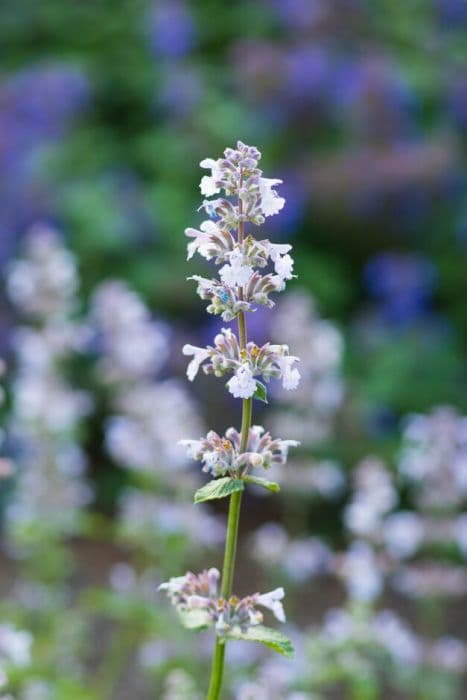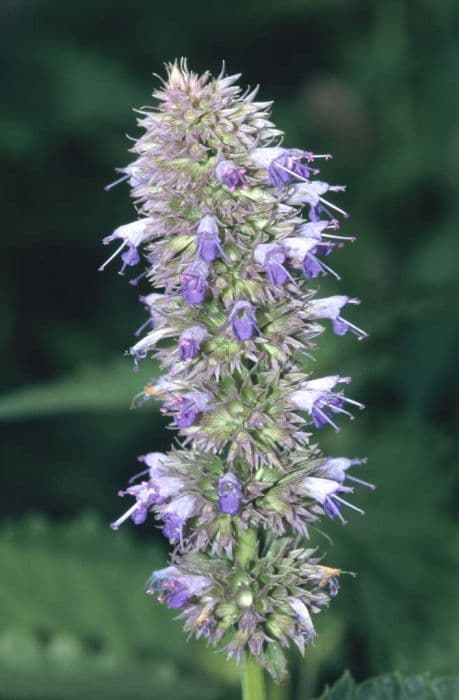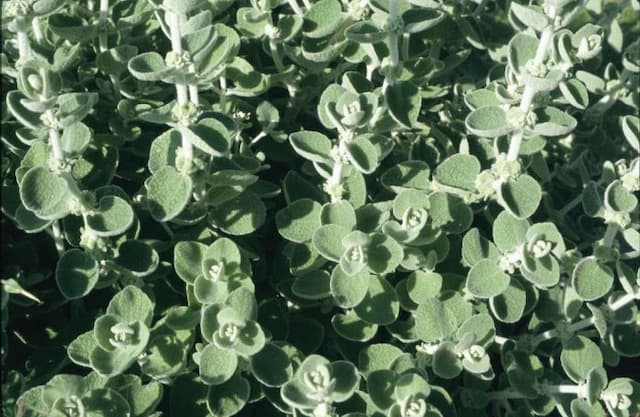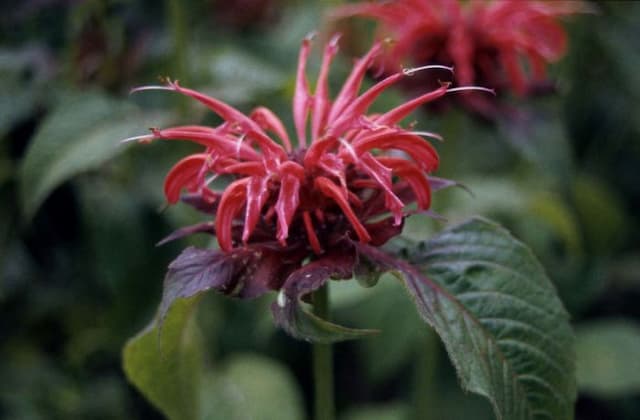Porcelain Blue Catmint Nepeta 'Porzellan'

ABOUT
Nepeta 'Porzellan', commonly known as catmint, flaunts a display of delicate, lavender-blue flowers that cluster on spikes atop the stems. The blooms are abundant and form a swath of cool, pastel tones throughout the blooming period. The foliage is a soft grey-green, comprising small, heart-shaped to oval leaves that are slightly serrated on the edges. They are aromatic when touched, releasing a refreshing, herbal scent that is characteristic of the Nepeta genus. The overall shape of the plant is mounding; it creates an undulating form that's filled with fine-textured leaves and frothy flowers. Catmint's growth habit makes it suitable as a border plant or as an accent in a perennial garden. It harmoniously combines with other plants, blending with a variety of garden color schemes and offering a soothing visual appeal.
About this plant
 Names
NamesFamily
Lamiaceae
Synonyms
Porcelain Catmint, Porcelain Nepeta
Common names
Nepeta 'Porzellan'.
 Toxicity
ToxicityTo humans
Nepeta 'Porzellan', commonly known as catmint, is generally not considered toxic to humans. Ingesting small amounts of this plant is unlikely to cause any significant or harmful symptoms. However, as with any non-food plant, individual allergies or sensitivities could result in mild gastrointestinal upset if ingested in larger quantities.
To pets
Catmint is known to be of low toxicity to pets. It is actually a plant that can have a stimulant effect on cats, similar to catnip, which is in the same genus. Cats may exhibit behaviors like rolling, pawing, or friskiness due to the nepetalactone compound in the plant. Dogs, on the other hand, aren't usually affected by this plant, and poisoning from the ingestion of catmint is rare. If your pet consumes a large amount, monitor for any unusual symptoms such as gastrointestinal upset, and consult your veterinarian if any concerns arise.
 Characteristics
CharacteristicsLife cycle
Perennials
Foliage type
Deciduous
Color of leaves
Green
Flower color
Lavender
Height
2 feet (0.61 meters)
Spread
3 feet (0.91 meters)
Plant type
Herb
Hardiness zones
3-8
Native area
Europe
Benefits
 General Benefits
General Benefits- Aesthetic Appeal: Nepeta 'Porzellan', commonly known as Catmint, adds beauty to gardens with its delicate, lavender-blue flowers and pleasing form.
- Drought Tolerance: Catmint is known for its ability to withstand dry conditions once established, making it suitable for water-wise landscapes.
- Attracts Pollinators: The flowers of Catmint are attractive to bees, butterflies, and other beneficial insects, supporting biodiversity.
- Low Maintenance: Catmint is easy to care for, requiring minimal attention once it is well-established in the garden.
- Deer and Rabbit Resistance: Catmint is generally resistant to browsing by deer and rabbits, making it a good choice for areas where these animals are prevalent.
- Fragrance: The foliage of Catmint releases a pleasant aroma when brushed against or crushed, which can add a sensory dimension to the garden.
- Pest Repellent: The scent of Catmint is said to deter some garden pests, making it a companion plant for certain vegetables and flowers.
- Long Blooming Period: Catmint blooms for an extended period, often from late spring into early fall, providing lasting color in the garden.
- Easy to Propagate: Catmint can be easily propagated from cuttings or divisions, allowing gardeners to create more plants for their garden or to share with others.
 Medical Properties
Medical PropertiesThis plant is not used for medical purposes.
 Air-purifying Qualities
Air-purifying QualitiesThis plant is not specifically known for air purifying qualities.
 Other Uses
Other Uses- Nepeta 'Porzellan', commonly known as catmint, can be used as a filler in cut flower arrangements, adding a light and airy component to bouquets with its delicate foliage and flowers.
- As a natural insect repellent, the strong scent of catmint can be utilized by placing dried leaves among clothes or linens to deter moths and other insects.
- The plant can be included in a sensory garden due to its textured leaves and aromatic nature, which can be appealing to touch and smell for an immersive experience.
- Catmint can be used in potpourris; its leaves maintain their fragrance when dried, contributing a pleasant aroma to any room.
- The essential oil derived from Nepeta 'Porzellan' can be used in homemade candles or scented sachets for a natural and calming fragrance.
- Due to its attractive and sprawling habit, catmint can be planted as ground cover to control erosion on slopes or disturbed areas in the garden.
- Catmint can be incorporated into companion planting strategies, as it is believed to enhance the growth and flavor of certain vegetables when grown nearby.
- Dried Nepeta 'Porzellan' can be added to homemade soaps for natural scenting and the potential benefits of its essential oils.
- Using catmint as a border plant can create a defined edge around garden beds or walkways, thanks to its uniform growth habit.
- Nepeta 'Porzellan' can be used in creative DIY projects, such as plant-dyed textiles or clothing, where its leaves and flowers may contribute natural colorants.
Interesting Facts
 Feng Shui
Feng ShuiThe plant Catmint is not used in Feng Shui practice.
 Zodiac Sign Compitability
Zodiac Sign CompitabilityThe plant Catmint is not used in astrology practice.
 Plant Symbolism
Plant Symbolism- Relaxation: Nepeta, commonly known as catnip or catswort, is often associated with its calming and relaxing effects on cats. This symbolism can extend to humans as well, representing the ability to relax and find comfort.
- Playfulness: Due to the euphoric effect catnip has on felines, it symbolizes playfulness and joy, reflecting the light-heartedness and fun it induces.
- Affection: As cats show a loving response to catnip, the plant can symbolize affection and the pleasant sensations associated with feeling loved or cherished.
- Protection: In herbal folklore, catnip is thought to have protective qualities, so it symbolizes safeguarding someone or something from harm or negative energy.
- Invisibility: Some myths suggest that catnip can make a person invisible to evil spirits, symbolizing protection and the power to avoid negative influences.
 Water
WaterCatmint should be watered regularly, especially during the first growing season to establish a deep, extensive root system. Once established, it is quite drought tolerant and needs less water. The soil should dry out slightly between waterings. As a general rule for established plants, provide about an inch of water per week, either through rainfall or manual watering. During the hot summer months or in particularly dry conditions, you may need to water twice a week, whereas cooler, moist periods will require less frequent watering. Avoid overhead watering to reduce the risk of leaf diseases.
 Light
LightCatmint thrives best in full sun, which means it requires at least six hours of direct sunlight daily. It can tolerate partial shade but will produce fewer blooms and may become leggy. Place it in a spot where it can receive ample sunlight for strong growth and optimal flowering performance.
 Temperature
TemperatureCatmint prefers temperatures between 60 and 70 degrees Fahrenheit but can survive in a range between approximately 30 degrees Fahrenheit during the winter and up to 85 degrees Fahrenheit in the summer. It goes dormant in colder weather and can survive winter freezes, but it is susceptible to damage from intense heat paired with high humidity.
 Pruning
PruningPrune catmint in the late fall or early spring to maintain its shape and encourage bushier growth with more blooms. Deadheading spent flowers during the growing season can also promote additional blooms. The best time to cut back the entire plant is after the first frost in fall or just before new growth starts in spring.
 Cleaning
CleaningAs needed
 Soil
SoilThe best soil mix for Catmint (Nepeta 'Porzellan') should be well-draining with a mix of loam, sand, and compost. Aim for a soil pH between 6.0 and 7.5 to ensure optimal growth and health.
 Repotting
RepottingCatmint (Nepeta 'Porzellan') is a hardy perennial and typically does not need frequent repotting; it should be repotted every 2 to 3 years, or as needed when it outgrows its current container.
 Humidity & Misting
Humidity & MistingCatmint (Nepeta 'Porzellan') is tolerant of a range of humidity levels and does best in average ambient humidity typical of outdoor conditions or a well-ventilated room.
 Suitable locations
Suitable locationsIndoor
Place Catmint in bright, indirect light with good air circulation.
Outdoor
Full sun, well-draining soil, water regularly until established.
Hardiness zone
3-8 USDA
 Life cycle
Life cycleThe Nepeta 'Porzellan', commonly known as Catmint, begins its life cycle when the seeds germinate in spring, requiring well-drained soil and a good amount of sunlight for successful sprouting. As it progresses to the seedling stage, the plant develops its distinctive grayish-green foliage and begins to form a compact, mounded habit. In the vegetative stage, the leaves continue to grow, and the plant starts to spread, reaching up to 24 inches in both height and width, depending on growing conditions. During the flowering stage, typically from late spring to early autumn, it produces spikes of small, lavender-blue flowers which attract bees, butterflies, and other pollinators. After its blooming period, Catmint sets seed, which can disperse to propagate new plants; simultaneously, it may also spread through its rhizome root system. Eventually, as winter approaches, Nepeta 'Porzellan' enters a period of dormancy, although it is a perennial and will rejuvenate and repeat this cycle when spring returns.
 Propogation
PropogationPropogation time
Spring-Early Summer
The most popular method of propagating Nepeta 'Porzellan', commonly known as Catmint, is through stem cuttings. This technique is best performed in late spring or early summer when the plant is actively growing. Take a 4 to 6-inch (10 to 15 cm) cutting from a healthy, non-flowering stem, making the cut just below a node where leaves emerge. Remove the leaves from the lower half of the cutting to prevent rot. Dip the cut end into rooting hormone powder to encourage root growth, and then place the cutting in a pot filled with a mixture of peat and perlite or sand. Ensure the pot provides adequate drainage and maintains the moisture without being excessively wet. Place the pot in a bright, indirect light location and wait for roots to develop, which usually takes a few weeks, before transplanting into the garden or a larger container.









